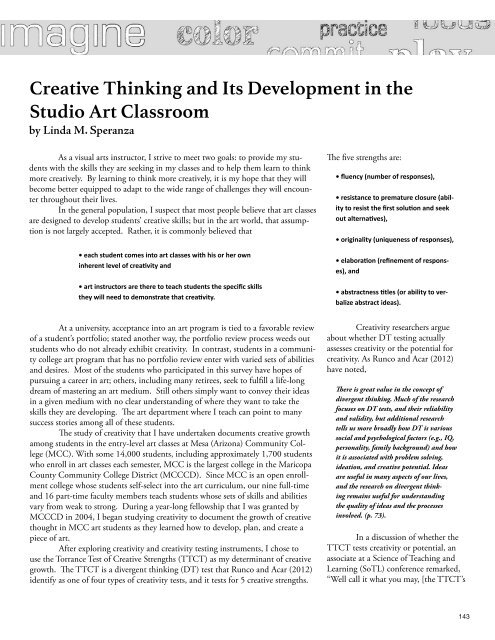Torrance Journal for Applied Creativity
TorranceJournal_V1
TorranceJournal_V1
Create successful ePaper yourself
Turn your PDF publications into a flip-book with our unique Google optimized e-Paper software.
Creative Thinking and Its Development in the<br />
Studio Art Classroom<br />
by Linda M. Speranza<br />
As a visual arts instructor, I strive to meet two goals: to provide my students<br />
with the skills they are seeking in my classes and to help them learn to think<br />
more creatively. By learning to think more creatively, it is my hope that they will<br />
become better equipped to adapt to the wide range of challenges they will encounter<br />
throughout their lives.<br />
In the general population, I suspect that most people believe that art classes<br />
are designed to develop students’ creative skills; but in the art world, that assumption<br />
is not largely accepted. Rather, it is commonly believed that<br />
• each student comes into art classes with his or her own<br />
inherent level of creativity and<br />
• art instructors are there to teach students the specific skills<br />
they will need to demonstrate that creativity.<br />
The five strengths are:<br />
• fluency (number of responses),<br />
• resistance to premature closure (ability<br />
to resist the first solution and seek<br />
out alternatives),<br />
• originality (uniqueness of responses),<br />
• elaboration (refinement of responses),<br />
and<br />
• abstractness titles (or ability to verbalize<br />
abstract ideas).<br />
At a university, acceptance into an art program is tied to a favorable review<br />
of a student’s portfolio; stated another way, the portfolio review process weeds out<br />
students who do not already exhibit creativity. In contrast, students in a community<br />
college art program that has no portfolio review enter with varied sets of abilities<br />
and desires. Most of the students who participated in this survey have hopes of<br />
pursuing a career in art; others, including many retirees, seek to fulfill a life-long<br />
dream of mastering an art medium. Still others simply want to convey their ideas<br />
in a given medium with no clear understanding of where they want to take the<br />
skills they are developing. The art department where I teach can point to many<br />
success stories among all of these students.<br />
The study of creativity that I have undertaken documents creative growth<br />
among students in the entry-level art classes at Mesa (Arizona) Community College<br />
(MCC). With some 14,000 students, including approximately 1,700 students<br />
who enroll in art classes each semester, MCC is the largest college in the Maricopa<br />
County Community College District (MCCCD). Since MCC is an open enrollment<br />
college whose students self-select into the art curriculum, our nine full-time<br />
and 16 part-time faculty members teach students whose sets of skills and abilities<br />
vary from weak to strong. During a year-long fellowship that I was granted by<br />
MCCCD in 2004, I began studying creativity to document the growth of creative<br />
thought in MCC art students as they learned how to develop, plan, and create a<br />
piece of art.<br />
After exploring creativity and creativity testing instruments, I chose to<br />
use the <strong>Torrance</strong> Test of Creative Strengths (TTCT) as my determinant of creative<br />
growth. The TTCT is a divergent thinking (DT) test that Runco and Acar (2012)<br />
identify as one of four types of creativity tests, and it tests <strong>for</strong> 5 creative strengths.<br />
<strong>Creativity</strong> researchers argue<br />
about whether DT testing actually<br />
assesses creativity or the potential <strong>for</strong><br />
creativity. As Runco and Acar (2012)<br />
have noted,<br />
There is great value in the concept of<br />
divergent thinking. Much of the research<br />
focuses on DT tests, and their reliability<br />
and validity, but additional research<br />
tells us more broadly how DT is various<br />
social and psychological factors (e.g., IQ,<br />
personality, family background) and how<br />
it is associated with problem solving,<br />
ideation, and creative potential. Ideas<br />
are useful in many aspects of our lives,<br />
and the research on divergent thinking<br />
remains useful <strong>for</strong> understanding<br />
the quality of ideas and the processes<br />
involved. (p. 73).<br />
In a discussion of whether the<br />
TTCT tests creativity or potential, an<br />
associate at a Science of Teaching and<br />
Learning (SoTL) conference remarked,<br />
“Well call it what you may, [the TTCT’s<br />
143


